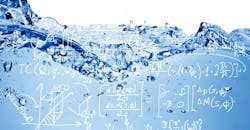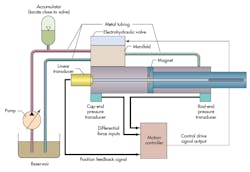Developing Useful Mathematical Models for Fluid Power
Download this article as a .PDF
Last month’s installment of "Motion Control" introduced the idea of analytical schematics, which are based on the existing family of standardized fluid power symbols (ISO R1219), while also attempting to convey some of the quantitative aspects of fluid power components. We will pursue that idea, but it must be preceded by some discussion of mathematical models, because schematics and models are merely different characterizations of the same thing. Specifically, we will address the question, “What is a mathematical model?”
A mathematical model is any equation or set of equations that quantifies the interactions among several system variables. As a basic example, consider the two very familiar equations that interconnect speed, torque, pressure, displacement, and flow in a hydraulic motor or pump:
T = (P × D) ÷ 2π, and Q = (D × N) ÷ 60
Where T is torque, lb-in.
P is pressure, psi
D is displacement, in.3/rev
Q is flow, in.3/sec, and
N is speed, rpm.
I must qualify these two equations, because they describe, in total, the complete operation of an ideal pump or ideal motor—that is, operation of a machine having no losses.
We all have used these equations to estimate certain operating conditions. For example, if we know the speed and torque needed to drive a certain load, we can rework the torque equation into its synthesis form by solving for the required displacement. We say we are designing the system, but we really mean properly sizing the components for hydraulic systems. This process allows us to go shopping for a real motor. We then select one that is probably a bit larger. This takes into account that the real machine will have losses, which must be accounted for if the application is to be successful.
The flow equation calculates the required flow at the design speed, from which pump requirements can be estimated, and so the design process continues. It is not the intent here to pursue the design process. The immediate aim is to look at mathematical models and how they relate to analytical schematics.
Roles and Limitations of Models
Mathematical models are put to different tasks, which immediately creates some problems while solving others. The major problem is that all mathematical models require assumptions that ultimately limit the model’s range of application. But assumptions are necessary to limit the time required both to develop the model and to implement it. A totally inclusive mathematical model of even the simplest real process would require so many equations and so much computational power to challenge even today’s fastest computers to achieve satisfactory results—if possible.
On the other hand, simplifying the model to its extreme might lead one to assume that the very objective of a given inquiry does not exist. Thus, the purpose of the model affects the form that the model must take. Palmberg said it well: “The definition of a good model is that it captures all the important characteristics of the studied object and leaves out the details that do not contribute to the final outcome.”
The idealized pump/motor model can illustrate this statement. If our objective is to study system inefficiencies under various operating conditions, the absurdity of starting with an idealized set of components reveals itself immediately. Clearly, if we begin with components that have no losses, then there can never be any inefficiencies present. If this is the case, the target of the inquiry has been assumed out of the picture at the outset. However, not all absurd assumptions are so obvious.
For example, consider the situation where we study the dynamic stability of a hydrostatic transmission operating under speed-feedback control in an attempt to maintain motor speed at some constant value. If we begin the study with the ideal models, we shall miss the significant contributors to loop stability, because friction and internal leakage make a significant contribution to damping and, therefore, affect the stability of the servo loop.
Consider friction. In a mathematical sense, friction is complex, but think of how it applies to the hydrostatic transmission. Suppose we are interested in the dynamic behavior of the control loop in going from, say, 1,000 to 2,000 rpm due to a change in input command. It would not be necessary to include stick-slip friction effects, because the shaft never stops. On the other hand, if we needed to watch dynamic behavior as the motor went from 1,000 rpm forward to 1,000 rpm backward, and if the reversal process was critical, then stick-slip effects would be essential in a mathematical model.
Not only that, we also would have to include both torque and internal leakage cogging that all motors are known to exhibit—characteristics that appear exaggerated at low speeds. The model required for such an investigation becomes much more complex—but still manageable—if we know enough about the performance of the pump and motor. In short, the aim of the investigation affects the nature and selection of the model that will be used. That is the major reason why modelers have difficulty agreeing upon the suitability of a given model. The purposes can be as varied as the users themselves.
Factors that Affect Models
Just as the intent of the model affects its form, the nature of available data has an effect on the model’s form. In particular, the nature of available data affects the knowledge base needed to use the model. For instance, suppose you need to know more about the hydrostatic transmission described above. A very good pump model may exist that includes, say, the diameter of slippers.
These models are usually the product of those who are interested in designing piston pumps. The user of that model will have to input the slipper diameter (and probably 20 or 30 other internal dimensions), which typically is not known by the person interested in studying application of the pump. The computer cannot solve the problem of the application of the pump until all internal dimensional data are entered into the program. It won’t run without them.
Such models are referred to as white box models, because they rely on extensive knowledge of internal details and always require a knowledge of parameters and coefficients that are not normally known by users of the equipment. Black box models are developed from performance data, and do not include any more of the internal details than are necessary to describe the dynamic input/output relationships. These types of models are usually more user-friendly, because they rely on measured performance and other data that are more readily available to the user. The process of creating a mathematical model from measured data is called synthesis, or process identification. It bears a close resemblance to design—the procedures are very similar and, in some cases, identical.
Interestingly, the methods of synthesis in the most general sense are probabilistic (meaning that statistical theories are required), as opposed to analysis methods, which are deterministic. As a result, the mathematical model synthesized can only be construed as “probably” describing the process that was modeled. Furthermore, because engineers are deterministic by their very nature, they resist the uncertainty that is an integral part of statistical processes. As a result, the statistical theories of process identification are not usually covered in undergraduate engineering curricula. Most models are gray boxes, which use a combination of knowledge about the machine’s innards along with some performance data.
Models also serve an extremely important educational function. In fact, academia traditionally has lead the way in model development, in the form of applied research. A great deal has been accomplished in modelling electronic components, but a gargantuan task faces us with modelling hydraulic components and systems. Models are quite good for cylinders and servovalves, and technical literature—both proprietary and generic—carries very useable data for low-frequency (≤100 Hz) applications.
If the operating conditions are well defined, accumulators are very predictable devices. Good models do not exist for other components, and catalogs and data sheets do not carry the information that is needed by modelers. We do not even have agreed-upon test methods to quantitatively and dynamically assess the dynamic coefficients needed to establish a model.
What’s Needed for the Future
If a good library of component models linked up with good design and analysis software, a remarkable opportunity would exist for students to learn a great deal about hydraulic machinery without extensive fluid power laboratory equipment. Even though simulation can never replace exposure to real equipment, good simulation programs could eliminate much of the fumbling that goes on in the lab, and could reduce the investment that schools must make in lab equipment.
However the mathematical model is derived, it will have limitations on use and applicability, and the user must be aware of those limits. Also, knowledgeable people will always be in dispute over the inclusiveness or lack thereof for any model. The not-invented-here syndrome has been known to creep into the process.
In the next installment, I will use a gray-box approach to develop and use linearized models of a hydraulic pump and motor and illustrate how the models can be used to estimate performance in other than test conditions.



